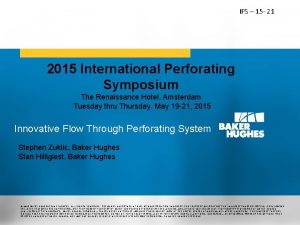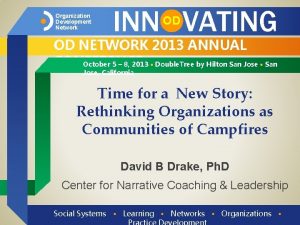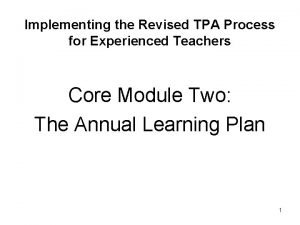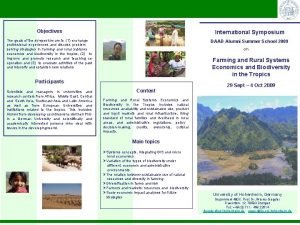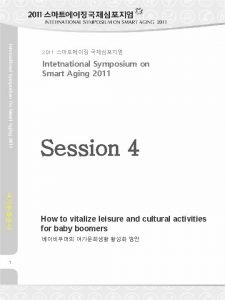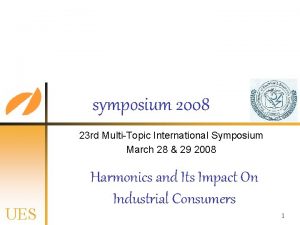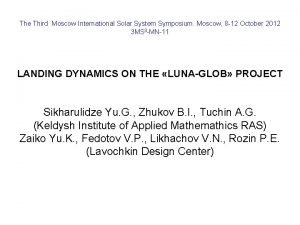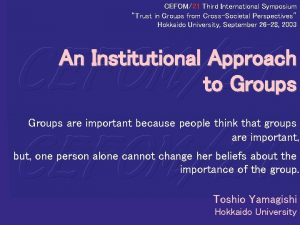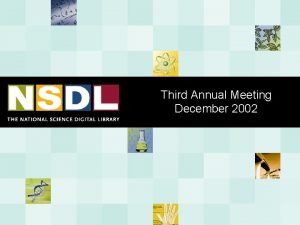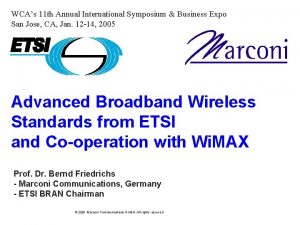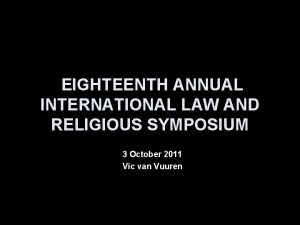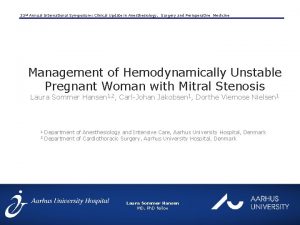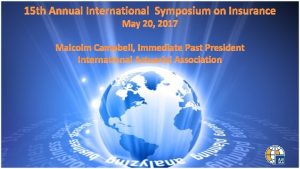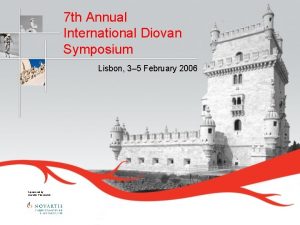The Third Annual Symposium of Learning International Network








































- Slides: 40

The Third Annual Symposium of Learning International Network Consortium The Massachusetts Institute of Technology 27 th-28 th October 2005 Cambridge, Massachusetts, USA The e-learning initiatives to reduce poverty and support socio-economic development in Lao PDR By: Ms. Sisavanh BOUPHA Deputy Director General, Department of Science and Technology

Contents 1. Introduction 2. Education and ICT 3. E-learning definition 4. Case study 5. Challenges 6. Links with economy issues 7. Future Plan

Lao People’s Democratic Republic (Lao PDR) • Capital: Vientiane • Area: 236. 800 Sq Km • Population: 5. 549. 000 • Mountainous: 70% • Language: Lao, Thai, French and English • GDP per capita: US$ 331/an • Economy: Agriculture based

Introduction • Lao. Net the first public e-mail centre at the National Polytechnic Institute in Lao PDR in December 1994. • There is a National Growth and Poverty Eradication Strategy (NGPES). ICT becomes a priority factor for socio-economic development particularly in support of all governance activities at the central and local levels. • Distance learning in “Agence Universitaire de la Francophonie” (AUF) in Vientiane, Lao PDR (2002). • Project of ASEAN Virtual Institute of Science and Technology (AVIST) at STEA (2005). The e-learning education has been recognized its importance and experimented among some of the students and professionals to upgrade their studies and knowledge.

Education & Academic Community n n n Universities • National University of Laos, NUOL (Vientiane Capital) • Souphanouvong University (North) • Champassak University (South) Colleges (10 -20) • Goverment and Public : 5 -10 • Private: 5 -10 Research Institutes (5 -10) • NAFRI National Agriculture and Forestry Institute (4 Research Centers) • Research Institutes in the Ministries

NUOL Students Number of Student (Excluded of Special/Night time course ) Years

Schools and access to ICT • The San Francisco Jhai Foundation together with Schools Online and local partners is setting up the first Internet Learning Center in the rural high school of Phon Song. • Mo. E plans to provide two secondary schools in each province with a computer and internet access by the year 2005. • Not yet public primary or secondary school have access to the Internet.

Human Resource devoted to R&D (FTE) FTE Person % Business Enterprise 68 25% 128 48% 72 27% Government Higher Education Private non-profit Not applicable Total 268 Population 5, 491, 000 R&D personnel per 10, 000 population 0. 488 100%

R&D Personnel by Sector of Performance 2002 SECTOR OF PERFORMANCES OCCUPATION BERD GOVERD HERD PNP GRAND TOTAL Researchers/Scientists/Engineers (RSE) Headcount FTE 59 26 109 31 41 30 209 87 RSE with Doctor Degree Headcount FTE 0 0 15 11 19 12 34 23 Technicians Headcount FTE 93 30 188 45 146 30 Other Supporting staff Headcount FTE 41 12 195 52 113 12 349 76 Headcount FTE 193 68 492 128 300 72 985 268 Total Not appl. 427 105

National R&D Survey Domestic Expenditure GENERAL GERD (million Kip) 6560 GERD ( 1000 US$) 656 GERD/GDP** (%) 0. 036 % Total R&D Personnel (Head count) 985 Total R&D Personnel (FTE) 268 Average Exchange Rate in 2002 (1 US$ = 10, 000 kip) ** GDP of LAO PDR in 2002 is 1, 805 Mil. US$

R&D Expenditure by Source of Fund SECTOR OF PERFORMANCE SOURCE OF FUNDS Business Enterprise Direct Government Higher Education Private Non Profit Funds from abroad TOTAL BERD GOVERD HERD PNP GERD Mil. Kip 2, 360 - - 2, 360 1000 US$ 236 - - 236 Mil. Kip - 530 - 1000 US$ - 53 Mil. Kip - - 100 1000 US$ - - 10 10 Mil. Kip Not applicable 530 53 Not applicable 1000 US$ Not applicable Mil. Kip 60 2, 810 700 3570 1000 US$ 6 281 70 357 Mil. Kip 2, 420 3, 340 800 6, 560 1000 US$ 242 334 80 656

Internet Situation in Lao PDR n n n 3 registered ISPs: Globe. Com, Laotel and STEA. 9. 000 internet users in September 2001 (a ratio of 1. 63 Internet users for every 1’ 000 inhabitants of Laos). Internet Access Fee: US$ 0, 76 -1, 51 per hour in November 2001 (Internet Cafes). Hi-speed Internet Leased Line available from 64 Kbps to 1024 Kbps. LANIC (Lao National Internet Committee) operating international gateway for public administration since 2002.


Internet and ISP Networking in Lao PDR THAICOM NUOL LANIC ETL CAT(BBK) Fiber link THAICOM SUBIC IXP KPL LAOTEL SINGNET STEA LANEXANG Fiber link Optic fiber Wireless SPEEDCAST Copper wire PLANET

E-Learning Definition E-learning means an approach to facilitate and enhance learning through the use of devices based on computer and communications technology. Such devices would include personal computers, CD-ROMs, Digital Television and Mobile Phones. Communications technology enables the use of the Internet, e-mail, discussion forums, and collaborative software.

E-Learning • E-learning is expected to be an effective learning system for enterprise, government staff, pupils and self-learners. • Education: 1 - Primary/Secondary 2 - Higher education and University 3 - Adult education, staff education 4 - Lifelong education

Case study ASEAN Virtual Institute of Science and Technology (AVIST) AVIST is an e-learning network for continuing professional development and advanced studies in science and technology with opportunities for real practice experience at participating institutes. Three e-learning courses: • Bioinformatics. • Introduction to Technology and Innovation Management. • Eco-tourism Learners at AVIST e-learning courses can learn at their own pace, anywhere and anytime. The course contents and communication means are in English. The web site is http: //www. avist. org

ASEAN Virtual Institute of Science and Technology (AVIST) Three types of registration: Registration Period Type A Type B-1 Type B-2 Anytime As designed by AVIST Course duration 12 months in total Interactions with instructor team No Yes Course assessment No No Yes Certificate No certificate Certificate of participation Certificate of achievement Registration fee Introductory Rate 1, 159 Bht Introductory Rate 4, 359 Bht Introductory Rate 5, 559 Bht

AVIST Infrastructure Temporary face-to-face training room at partner institutions Satellite Permanent Learning Resources Centers at local universities/institutes Content Flow AVIST Content Center LAN Primary Content Dissemination Center Internet Cafes Secondary Content Dissemination Center Dial-up from homes / offices Secondary Content Dissemination Center Tertiary Content Dissemination Center

Agence Universitaire de France (AUF) • The distance learning is taken place in the “Agence Universitaire de la Francophonie” (AUF) in Lao PDR since 2002. AUF will offer the scholarships for the selected excellent candidates on the distance learning. • There are many disciplines: economy and rights, ICT and engineering science, electronic and communication, life and earth science, medical science and fundamental science (chemistry, mathematics). • The Number of students registered in the year 2004 -2005 are 86 including 12 students from Laos. • The web site called http: //foad. refer. org

Lessons learned • These courses are significant for the students and teachers at the university to upgrade their knowledge and skills, to keep aware of ICT technology for education and to share information with others. These do not mean that we succeeded at making significant economic change. • The number of Lao students is very small. They are not much interested in the topic. In addition, the course is done in English and French language. • The context might affect to the future priorities for poverty reduction. We have to examine and consider the aid projects in this sector for the linkages to the wider economy.

Challenges • Lack of financial resources to education. • Lack of telecommunications and public infrastructure. • A demographic and geography characteristic necessitate an understanding of the main income sources. • Poor quality of education, shortage of teachers and learning materials and curriculum inappropriate to the needs of development. • Cost fee of internet is high. High long distance call charges lead to high costs for national access. • Lack of standards in both public and private sector related to Lao script, software and hardware for LAN, WAN, and Intranet. • Lack of R&D on ICT. • Lack of coordination leading to duplication and inefficiencies of the activities.

Poverty reduction • The National Growth and Poverty Eradication Strategy is a comprehensive framework for sustainable growth and poverty eradication focus on the improvement of the poverty situation in the poorest districts. ICT has been prioritized as an important tool to enhance productivity and will help to create conditions for support economic development. • Create a supportive environment for intraregional trade, promote a cooperation mechanism for an knowledge based society/economy, develop HRD and enhance institutional capacity building. • Encourage the cooperation with private sector and international community.

Links with economic issues Key issues: Rural and urban development • Provide industrial structure, telecommunication services, increase level of compulsory education, improve quality of education, promote population distribution in balance between urban and rural areas for revenue distribution, develop IT and technologies for food production and distribution, medical technologies for health care and create employment. • • • Development of agriculture, industry, trade and commercial services Develop grass-root economy in key areas such as: agriculture, rural industry combine with IT by providing specialized technical education and strengthening SME enterprises to enhance selfsufficiency and viability of domestic economy. Develop curriculum and learning materials for exploiting indigenous knowledge to be marketed and competitive with others. Promote trade policies and international trade.

Links with economic issues (Cont. 1) Labour and skills • Provide education and research in new technology areas (biotechnology, genetic engineering, new materials, …). • Improve e-learning technologies and multimedia technologies. Balance between local and global aspects • Provide contents with balance between local and global aspects, technology transfer and self-reliance.

E-learning for long-term sustainable economic growth • Improve living standard • Productivity • Increase markets Price Quality Operations Management • Production Course wares • Broadcasting & Distribution • Create jobs • Revenue growth • Increase human and information capital Market opportunity Labour, Products and Services Markets Learners Analysis Service R&D and innovation • Satisfaction • Low-Cost • Social needs • Create new products and services • Develop research aligned with targeted growth areas Human Capital Skills Knowledge Values Certification & Accreditation Regulatory and Anti-poverty Policy • Invest in infrastructure • ICT policy • Economic growth • Promote FDI and trade • Education and HRD • Incentive framework • Promote public-private collaboration • IPR • Standard and security Information Capital (Systems, Databases, Networks, Curriculum development and Technology) Organizations (Linkages, Culture of creativity and innovation and Competitiveness) Enterprises Learning Institutes STEA NUOL

Future Plan • Infrastructure • Policy • Regulation frameworks • Research and development • Investment

Lao National Research & Education Network Internet …China-Vietnam Thailand-Singapore-Malaysia… (TEIN) STEA NUOL (A-ISP) NAFRI Other Gov. Uni. Private Colleges Research Institutes Research Centers Proposed basic topology : • Research and Education Community in Lao PDR • Case of NUOL acting as an Academic ISP

Members of Lao NREN (Estimation) Phase I : NUOL (Main Campus), NAFRI, STEA Phase II : MOE, Other Faculties, Library of NUOL, National Library… Vientiane College, Lao-American College … Phase III : Other Universities (Souphanouvong, Champassak University) … Other Research Institutes or Centers (attached to the Ministry)

/G Z China The proposed Academic backbone to TEIN Province District Phase 1 (2001) Phase 2 Phase 3 Vietnam Hanoi Vientiane Khornkean U. CSC ports to Inter. Other possibility ports k gko CSC (Link to TEIN 2) Ban (Dec. 2004) Vinh 430 km Thailand Phase 4 SH ETL Fiber backbone & Cambodia

Connection to TEIN 2 n n n 1. CSC cable x*2. 4 Gbps SDH. . . - Shanghai – Hanoi – Vientiane – Bangkok Kuala Lumpur – Singapore -. . . 2. Satellite (not preferred) Interconnect to Thai. SARN in Thailand and/or STEnet in Vietnam Demand for bandwidth is high Sustainable solution depends on cost

Trans-Eurasia Information Network (TEIN)

Comparison of methods Method System Cost Satellite Live Interactive On demand High The Internet Media Moderate DVD CD-ROM Low Required infrastructure Expected user Satellite The Internet (Broadband) University Government Enterprise Self-learner Stand-alone PC Pupil Self-learner

POLICY • Link the National Growth and Poverty Eradication Strategy to the National Socio-Economic Development Plan. • Establish an Information Superhighway Network with high speed data transmission over fiber optic cables and regional telecommunications connections to facilitate training, capacity building on human resource development and establish a National Internet Exchange Network for ISP for making the cost affordable to the users. • Promote and support the wide utilization of distance learning and e-learning as well as facilitate universal access through networking in order to ensure the enhancement of capacities and increase employability. • Develop R&D on ICT to promote distance and e-learning. • Promote digital interchange in Lao language.

POLICY • Promote FDI, trade, incentive frameworks, ICT policy and develop local ICT enterprise on multimedia content and electronics services. • Linking learning institutes between the public sector, private sector and enterprises for wide utilization of information. • Develop closer cooperation with international organizations in priority areas: infrastructure, IT, HRD and economic development. • Promote certification and accreditation of e-learning network at national and regional level to improve competence of human resources. • Raise an awareness of the public on the importance, benefits and advantages of e-learning for poverty reduction and support socio-economic development. • Prepare the young generation towards the universe of new technology.

Regulation frameworks • Cyberlaws • Cybercrime • Cybersecurity • E-commerce • Information, IPR and Consumer protection • Digital Content Management • Privacy

Research & Development • Promote joint Research and Development in areas having potentials for commercial applications with the involvement of public and private sector. • Establish a Technology Transfer Network to facilitate the pooling of information on the availability of technologies and experts with the enterprises/R&D organizations.

Investment • Telecommunications and Public Infrastructure • Human Capital • Information Capital

Conclusion • Not a fast moving in implementing e-learning system due to limited financial resources and human capacity. • Get government support and encourage the involvement of private sector and local community. • Promote the cooperation with international organizations in priorities areas through various training courses, e-learning, seminars, workshops and exchange of visits among experts. • Focus on the solid content in service to the teaching and learning for poverty reduction and support economic development not only the enormous investment of networks and technologies.

 International police executive symposium
International police executive symposium Ips perforating
Ips perforating International perforating symposium
International perforating symposium Ips perforating
Ips perforating International perforating symposium
International perforating symposium International perforating symposium
International perforating symposium International perforating symposium
International perforating symposium International symposium on molecular spectroscopy
International symposium on molecular spectroscopy Forward and backward caries definition
Forward and backward caries definition Blacks classification
Blacks classification Od network
Od network Cuadro comparativo de e-learning b-learning y m-learning
Cuadro comparativo de e-learning b-learning y m-learning Annual learning plan examples
Annual learning plan examples Annual learning plan ideas for teachers
Annual learning plan ideas for teachers Hình ảnh bộ gõ cơ thể búng tay
Hình ảnh bộ gõ cơ thể búng tay Slidetodoc
Slidetodoc Bổ thể
Bổ thể Tỉ lệ cơ thể trẻ em
Tỉ lệ cơ thể trẻ em Voi kéo gỗ như thế nào
Voi kéo gỗ như thế nào Tư thế worm breton là gì
Tư thế worm breton là gì Bài hát chúa yêu trần thế alleluia
Bài hát chúa yêu trần thế alleluia Các môn thể thao bắt đầu bằng từ đua
Các môn thể thao bắt đầu bằng từ đua Thế nào là hệ số cao nhất
Thế nào là hệ số cao nhất Các châu lục và đại dương trên thế giới
Các châu lục và đại dương trên thế giới Công của trọng lực
Công của trọng lực Trời xanh đây là của chúng ta thể thơ
Trời xanh đây là của chúng ta thể thơ Mật thư tọa độ 5x5
Mật thư tọa độ 5x5 101012 bằng
101012 bằng Phản ứng thế ankan
Phản ứng thế ankan Các châu lục và đại dương trên thế giới
Các châu lục và đại dương trên thế giới Thể thơ truyền thống
Thể thơ truyền thống Quá trình desamine hóa có thể tạo ra
Quá trình desamine hóa có thể tạo ra Một số thể thơ truyền thống
Một số thể thơ truyền thống Bàn tay mà dây bẩn
Bàn tay mà dây bẩn Vẽ hình chiếu vuông góc của vật thể sau
Vẽ hình chiếu vuông góc của vật thể sau Thế nào là sự mỏi cơ
Thế nào là sự mỏi cơ đặc điểm cơ thể của người tối cổ
đặc điểm cơ thể của người tối cổ Thế nào là giọng cùng tên? *
Thế nào là giọng cùng tên? * Vẽ hình chiếu đứng bằng cạnh của vật thể
Vẽ hình chiếu đứng bằng cạnh của vật thể Phối cảnh
Phối cảnh Thẻ vin
Thẻ vin


